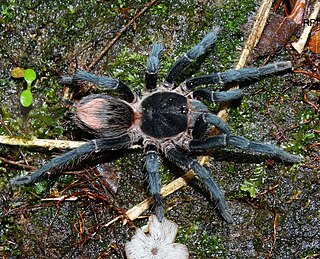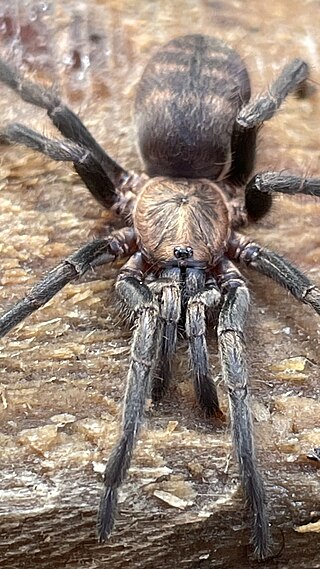
Actinopus is a genus of mygalomorph spiders in the family Actinopodidae. It was first described by Josef Anton Maximilian Perty in 1833 from the type species Actinopus tarsalis found in Brazil. The name is derived from Greek actin- "ray, beam" and pous "foot". It is a senior synonym of Aussereria, Closterochilus, Pachyloscelis, and Theragretes.

Microstigmatidae is a small family of spiders with about 38 described species in eleven genera. They are small ground-dwelling and free-living spiders that make little use of silk.

Nemesiidae, also known as funnel-web trapdoor spiders, is a family of mygalomorph spiders first described by Eugène Simon in 1889, and raised to family status in 1985. Before becoming its own family, it was considered part of "Dipluridae".

Idiops is a genus of armored trapdoor spiders that was first described by Josef Anton Maximilian Perty in 1833. It is the type genus of the spurred trapdoor spiders, Idiopidae. Idiops is also the most species-rich genus of the family, and is found at widely separated locations in the Neotropics, Afrotropics, Indomalaya and the Middle East. Females live in tubular burrows lined with a thick layer of white silk. These typically have a D-shaped lid that fits into the entrance like a cork, and some burrows have two entrances. The lid may consist of mud, moss or lichen, which is bound below by a thick layer of silk. As in all genera of this family, the anterior lateral eyes (ALE) are situated near the clypeal margin, far in front of the remaining six eyes, which are arranged in a tight group. The males which are smaller in size, wander about or occasionally live in burrows. Like other mygalomorphs, they are relatively large and long-lived. Forest clearance and agricultural practices that loosen the soil and enhance erosion, besides soil removal for brick making have been pointed out as serious threats to some Indian species. Species ranges are poorly known – in India for instance, most species are known only from their type localities.
Stenoterommata uruguai is a mygalomorph spider of Argentina, named after its type locality: Salto del Uruguaí. This species is distinguished from other Stenoterommata by its spermathecae consisting of a single dome bearing numerous receptacula. Its spermathecae are similar to those of S. quena, but in S. uruguai the basal dome is more rounded.
Acanthogonatus alegre is a mygalomorph spider of Chile, its name using the Spanish word for “happy”, referring to the aspect of a happy face that the female epigastrium has in posterior view. Females are recognized by the epigastrium produced in a membranous extension and the long, slender and bifurcated spermathecae.

Acanthogonatus is a genus of South American mygalomorph spiders in the family Pycnothelidae. It was first described by Ferdinand Anton Franz Karsch in 1880. Originally placed with the brushed trapdoor spiders, it was transferred to the funnel-web trapdoor spiders in 1985, then to the Pycnothelidae in 2020.
Chaco is a genus of spider in the family Pycnothelidae.
Lycinus is a genus of spider in the family Pycnothelidae, found in parts of South America.

Fufius is a genus of Central and South American Rhytidicolidae that was first described by Eugène Simon in 1888. Originally placed with the curtain web spiders, it was moved to the Cyrtaucheniidae in 1941 and to Rhytidicolidae in 2022.

Homoeomma is a genus of South American tarantulas that was first described by Anton Ausserer in 1871. It is considered a senior synonym of Calopelma, Butantania, and of Cyclothoracoides. These tarantulas are usually quite small and usually burrow a few centimeters under a rock or log.

Vitalius is a genus of South American tarantulas that was first described by S. Lucas, P. I. da Silva Jr. & Rogério Bertani in 1993.
Hermacha is a genus of mygalomorphae spiders in the family Entypesidae. It was first described by Eugène Louis Simon in 1889. Originally placed with the Ctenizidae, it was transferred to the funnel-web trapdoor spiders in 1985, then to the Entypesidae in 2020. It is a senior synonym of Damarchodes and Hermachola.
Pycnothele is a genus of South American mygalomorph spiders in the family Pycnothelidae. First described by Ralph Vary Chamberlin in 1917, it was moved to the funnel-web trapdoor spiders in 1985, but moved back to Pycnothelidae in 2020. It is a senior synonym of Agersborgia and Androthelopsis.

Pycnothelidae is a family of mygalomorph spiders first described in 1917. It was downgraded to a subfamily of the funnel-web trapdoor spiders in 1985, but returned to family status in 2020.

Fufius lucasae is a spider in the family Rhytidicolidae, native to Brazil. It was first described in 2004 by Guadanucci and Indicatti. The specific name lucasae honours Sylvia M. Lucas.








